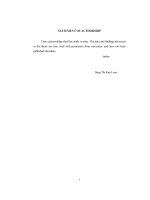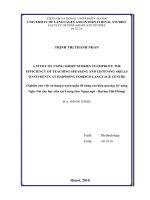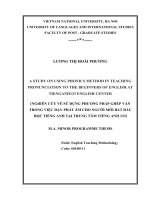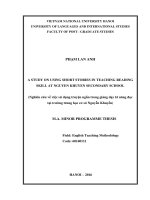A study on using short stories in teaching reading skill at nguyen khuyen secondary school
Bạn đang xem bản rút gọn của tài liệu. Xem và tải ngay bản đầy đủ của tài liệu tại đây (459.59 KB, 12 trang )
VIETNAM NATIONAL UNIVERSITY HANOI
UNIVERSITY OF LANGUAGES AND INTERNATIONAL STUDIES
FACULTY OF POST - GRADUATE STUDIES
PHẠM LAN ANH
A STUDY ON USING SHORT STORIES IN TEACHING READING
SKILL AT NGUYEN KHUYEN SECONDARY SCHOOL
(Nghiên cứu về việc sử dụng truyện ngắn trong giảng dạy kĩ năng đọc
tại trường trung học cơ sở Nguyễn Khuyến)
M.A. MINOR PROGRAMME THESIS
Field: English Teaching Methodology
Code: 60140111
HANOI – 2016
VIETNAM NATIONAL UNIVERSITY HANOI
UNIVERSITY OF LANGUAGES AND INTERNATIONAL STUDIES
FACULTY OF POST - GRADUATE STUDIES
PHẠM LAN ANH
A STUDY ON USING SHORT STORIES IN TEACHING READING
SKILL AT NGUYEN KHUYEN SECONDARY SCHOOL
(Nghiên cứu về việc sử dụng truyện ngắn trong giảng dạy kĩ năng đọc
tại trường trung học cơ sở Nguyễn Khuyến)
M.A. MINOR PROGRAMME THESIS
Field: English Teaching Methodology
Code: 60140111
Supervisor: Mai Thị Loan, PhD
HANOI - 2016
CANDIDAT’ES STATEMENT
I certify my authorship of the thesis submitted today entitled:A STUDY OF
USING SHORT STORIES IN TEACHING READING SKILL AT NGUYEN
KHUYEN SECONDARY SCHOOL is the result of my own work for the Degree of
Master of Arts at University of Languages and International Studies, Hanoi
National University. The material in this thesis has not been submitted for
assessment in any other courses of study.
Hanoi,2016
Signature
Phạm Lan Anh
23
ACKNOLEDGEMENT
First of all, I would like to express my deep and faithful gratitude to my
supervisor, Ms Mai Thi Loan, PhD. for her whole hearted and valuable guidance,
significant suggestions and useful materials in the process of writing this thesis.
Thanks to her noble devotion, the research report has been successfully completed.
My sincere thanks were also presented to my classmates for their support and
recommendations in choosing necessary materials so that I can fulfill this study.
Their sincere friendship has encouraged me a lot.
I would like to thank to teachers and students at Nguyen Khuyen secondary
school for their constructive suggestions and important help. Without their support,
there would not be a completion of this thesis.
I also thank our university library for their sources of books and documents
about methodology studies. In addition, I was grateful to researchers, authors and
teachers whose materials suggest necessary information for my reference.
My true family deserves my gratefulness for their long lasting help and
encouragement so that I have been able to complete this study.
24
ABSTRACT
Reading comprehension has been highlighted as a problem among secondary
school students. This study examined the effects of short stories on 80 seven grade
students to show if the method had an impact on students’ reading comprehension.
Besides, this research also figured out the suitable methods teachers used to exploit
short stories in teaching reading skill. To serve this purpose, some instruments were
used: pre-test, post-test; questionnaire for teachers and questionnaire for students.
Although the findings revealed some limitations, the use of short stories helped
students to improve their reading comprehension. The result in reading test showed
a slight improvement on the students’ average score. In addition, the result from
questionnaire and interview indicated both teachers and students had difficulties
when teaching and learning reading through short stories. However, many suitable
methods had been applied to help students and teachers overcome these obstacles
and ensure the better use of short stories in teaching reading skill. It is thus
recommended for further studies to minimize the challenge found in this study and
vary kinds of short stories used in teaching English skills.
25
PART I: INTRODUCTION
1.
Rationale of the study
Reading comprehension, as a fundamental language skill, requires a complex
acquisition process which can account for the way that learners comprehend what
they read. Many of the Vietnamese students are suffering from the weakness in
reading comprehension. Especially, based on individual teaching experience, the
researcher finds out that the capability of understanding English text of students at
Nguyen Khuyen secondary school is very poor. The problem is that the 7th graders
in this school lack the ability of reading comprehension, so because of
misunderstanding the meaning of the text, they find it difficult to answer questions
related to the specific text and get bad scores in reading tests. It is the reason why
many students dislike, even fear of English classes. One of the main causes of this
problem is because of the boring and unattractive traditional method most of
teachers use in teaching reading comprehension. This fact raises a question of how
to make the students interested in reading English text and how the teachers choose
the suitable materials that motivate students to read.
In fact, many researchers and educators have made untiring attempts to find
more efficient ways of enabling the learners to become more proficient readers.
Teaching English through literature has become the fashionable phenomenon. Some
researchers believe that teachers provide students with heavy, boring and somewhat
redundant literature which has no use to solve students’ problems and provides no
room for creativity. The students are taught literary terms, the meaning of words
and the process of analysis; therefore, they take the form of repeating the material
understanding mostly by memorization. The idea of using short stories in teaching
comprehension may come as an effective way to deal with this problem. It helps
students to cope with original texts, use the language creatively, improve their
26
language level, loose themselves from the barriers of instructional texts and even
learn some literature.
Based on the explanation above, the researcher decides to conduct a study on
using short stories in teaching reading skill for the 7th grade students at Nguyen
Khuyen secondary school.
2.Aims and objectives of the study
The study aims at investigating the use of short stories in teaching reading skill for
the seventh graders at Nguyen Khuyen secondary school.
To be more specific, the objectives of this study are to:
- find out the degree of effectiveness of using short stories to teach reading skill
for the 7th grade students at Nguyen Khuyen secondary school.
- propose some suggestions to teach reading skill for students with the use of
short stories
3. Research questions
In order to reach the above aims and objectives, the study is going to seek
answers for the following research questions:
a. To what extent can reading short stories affect students’ reading skill?
b. What are methods of using short stories in teaching reading skill?
4. Scope of the study
In this study, the writer intends to deal with the questions that how effectively
short stories are used in teaching reading comprehension for students, and what
suitable ways of using short stories to teach reading skill are. The short stories used
in this research are one page long with simple contents and various topics such as
friendship, love and moral lessons.
5. Significance of the study
By looking into the perception of the use of short stories in teaching reading
comprehension and the satisfaction of students about their achievement and
improvement in reading skill, the study is hoped to raise teachers’ awareness,
27
REFERENCES
1. Abrams, M. H. (1970). A Glossary of Literary Term. New York: Rinehart.
2. Aebersold, J. A. and M. L. Field. 1997. From Reading to Reading Teacher:
Issues and Strategies for Second Language Classrooms. Cambridge: Cambridge
University Press.
3. Aiptekin,C. (2006). Cultural familiarity in inferential and literalcomprehension
in L2 reading.System,34, 494–508.
4. Celce-Murcia, M. Dornyei, Z., & Thurrell, S. (1995). Communicative
competence: A pedagogically motivated model with content specifications.Issues in
Applied Linguistics, 6, 5-35.
5. Collie, J & Slater, S. (1987). Literature in the Language Classroom. Cambridge
University Press.
6. Collie, J. & Slater, S. (1991). Literature in the language classroom. (5th ed.)
Glasgow: Cambridge University Press.
7. Chastain, K. (1988) Developing Second Language Skills (3rd ed.). Chicago:
Harcourt Brace Jovanovich.
8. Chittenden, E. & Salinger, T. (2001). Inquiry into meaning: An investigation of
learning to read. New York: Teachers College Press.
9. Dörnyei, Zoltán. (2003). Questionnaires in Second Language Research.
Mahwah.
10. Duke, N. K. & Pearson P. D. (2002). Effective practices for developing reading
comprehension.What Research Has To Say About Reading. International Reading
Association, Inc.
11. Đào Thị Minh Hương. (2010). The relationship between first-year Nghe An
college students’ motivation to read and their use of reading strategies.Unpublished
MA thesis, English Linguistics Teaching Methodology – University of Languages
and International Studies. Vietnam National University, Hanoi.
28
12. Foorman, B. R., Francis, D. J., Fletcher, J. M., Schatschneider, C., & Mehta, P.
(1998). The role of instruction in learning to read: Preventing reading failure in atrisk children. Journal of Educational Psychology, 90, 37-55.
13. Fuchs, L. S., D., Hosp, M. K., & Jenkins, J. R. (2001). Oral reading fluency as
an indicator or reading competence: A theoretical, empirical, and historical
analysis.Scientific studies of Reading, 5, 239-256.
14. Gajdusek, L. (1988). Toward wider use of literature in ESL: Why and
how.TESOL Quarterly,22(2), 227-257.
15. Gillet, J. W., & Temple, C. (1994). Understanding reading problems:
Assessment and instruction(4th ed.). New York: Harper Collins.
16. Grellet,F. (1981). Developing Reading Skills. Cambridge: Cambridge
University Press.
17. Grellet, F. (1998). Developing Reading Skills. New York : Cambridge
University Press.
18. Harmer, J. (2001). The Practice of English Language Teaching. Pearson
Education.
19. Heilman, Blair and Rupley. (1981). Principle and Practices of Teaching
Reading,5th Edition. Colombus Ohio: Charles E. Merrill Publishing Co.
20. Hill, J. (1994). Using literature in language teaching. London: Macmillan.
21. Hismanoglu, M. (2005). Teaching English through Literature.Journal of
Language and Linguistic Studies, 1(1), 53-66.
22. Howie, S.H. (1993). Critical Thinking: A Critical skill for students.Reading
Today,24.
23. Lazar, G. (1990). Using novels in the language learning classroom.ELT
Journal, 44, 205-214.
24. Lazar, G. (1993). Literature and language teaching. Cambridge: Cambridge
University Press.
25. Merli, P. H. (2013). Using children short stories to enhance students reading
comprehension. Journal of English and Education 2013, 1(1), 133-141.
29
26. Miller, D. (2002). Reading with Meaning Teaching Comprehension in the
Primary Graders. Portland: Stenhouse.
27. Murdoch, G. (2002). Exploiting well-known short stories for language skills
development. IATEFL LCS SIG Newsletter 23, 9-27.
28. Nguyễn Hồng Quyên. (2006). Intergrating short stories and poems in
developing the reading skills for 2nd year students in Haiphong University.
Unpublished MA thesis, English Linguistics Teaching Methodology – University of
Languages and International Studies. Vietnam National University, Hanoi.
29. Noura, J.O. (2012). The Effect of Using Animation on 6th Graders’ attitudes and
Comprehension of Short Story in Gaza Governmental Schools.Unpblished M.A
thesis in Education – the Curricular & English Teaching Methods Department
Faculty.
30. Omid, P. & Nasibeh, K. (2013). Teaching reading comprehension through short
stories in advance classes.Asia journal of social sciences and humanities,2(2).
31. Pardede, P. (2011). Using short stories to teach language skills. Journal of
English Teaching,1(1), 14-27.
32. Parvin, G. & Rasool, H. (2011).Teaching L2 Reading Comprehension through
Short Story.2011 International Conference on Language, Literature and
Linguistics, IPEDR vol.26. Singapore: IACSIT Press.
33. Phạm Thu Hà. (2009). Using short stories in teaching English in the context of
Viet Nam Australia School – Ha Noi.Unpublished MA thesis, English Linguistics
Teaching Methodology – University of Languages and International Studies.
Vietnam National University, Hanoi.
34. Salinger, T. (2003). Helping older struggling readers.Preventing School
Failure,47(2). 79-85.
35. Seliger, H. W.& Shohamy, E. (1989). Second language research methods.
Oxford: Oxford University Press.
36. Young, A. (2006). Introducing critical thinking at the college level with
children’s stories.College Teaching,44(3), 90.
30
37. Wallace, C. (1992). Language Teaching: A Scheme for Teacher Education.
New York: Oxford University Press.
38. Webster’s New World College Dictionary. (2010). University of Liverpool.
39. Williams. (2002). Learning Strategies Resource Guide. University of south
Florida: Litton/PRC, Inc.
40. Wisker,G. (2001). The post graduate research handbook. London: Palgrave.
41. Widdowson, H.G. (1983). Talking Shop: H. G. Widdowson on Literature and
ELT. ELTjournal 37, 1.
42. Wisker, G. (2007). The Postgraduate Research Handbook: Succeed with Your
MA, MPhil, EdD and PhD. Palgrave Macmillan.
43. Wright, A. (1995).Storytelling with Children. Oxford University Press.
44. Carrier, G. (2006). Comprehension. Retrieved May 10, 2007, from
/>45. Erkaya, O. R. (2005). Benefits of using short stories in the EFL context.Asian
EFL Journal. Vol8. 38-49. . Current as of January 5th,
2013.
46. Moats, L. (2002). When older students can’t read. Retrieved May, 10, 2007,
from />47. Mohammad, K. & Atefeh, N. (2012). Enhancing reading comprehension
through short stories in Iranian EFL learners.Theory and Practice in Language
Studies.Vol.2. No2. 240-246. . Current as of January
15th, 2013.
48. />49. />
31
I









